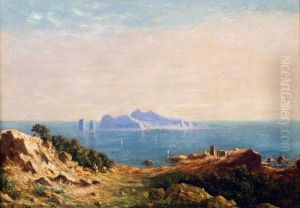Johanne Krebs Paintings
Johanne Krebs was a Danish landscape painter born in 1867, whose work is often celebrated for its poetic interpretation of the Danish landscape. Unlike many of her contemporaries, Krebs pursued her artistic career at a time when female artists faced significant barriers in gaining recognition and acceptance in the art world. Despite these challenges, she managed to carve out a unique place for herself in Danish art history, largely through her dedication, skill, and distinctive approach to landscape painting.
Krebs' education in art began at the Royal Danish Academy of Fine Arts, where she studied under some of the most prominent Danish artists of her time. Her training there was traditional, focusing on drawing and painting from life, but Krebs soon developed her own style, characterized by a delicate use of color and light, and a deep sensitivity to the nuances of the natural world. Her landscapes are not just representations of places; they are imbued with a sense of mood and atmosphere, often reflecting the changing seasons and the ephemeral qualities of light.
Throughout her career, Johanne Krebs participated in numerous exhibitions, both in Denmark and abroad, gaining a modest but dedicated following. Her work was appreciated for its lyrical beauty and its ability to evoke a sense of peaceful contemplation. Despite her achievements, she remained relatively unknown outside of Denmark, largely because she worked at a time when the international art world was focused on other styles and movements.
Krebs' legacy is that of a pioneering woman artist who managed to overcome the societal restrictions of her time to produce a body of work that remains a testament to her love for the Danish landscape. She passed away in 1950, but her paintings continue to be exhibited and appreciated for their quiet beauty and emotional depth, offering a window into the serene and contemplative landscapes of Denmark.


